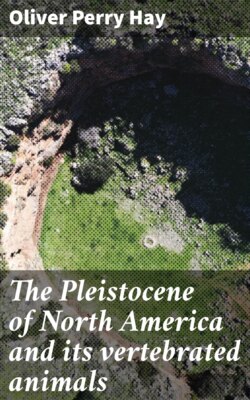Читать книгу The Pleistocene of North America and its vertebrated animals - Oliver Perry Hay - Страница 47
На сайте Литреса книга снята с продажи.
GEORGIA.
ОглавлениеTable of Contents
(Map 3.)
1. Brunswick, Glynn County.—In 1842 (Proc. Acad. Nat. Sci. Phila., vol. I, p. 189), Richard Harlan gave to the Academy of Natural Sciences a number of bones which had been collected in the Brunswick Canal by Mr. J. H. Couper and sent to the Academy. Among these was a number of bones of Megatherium. A part of a lower jaw contained 4 teeth. A list of the bones is presented by Couper on page 44 of William B. Hodgson’s memoir on Megatherium published in 1846. There were, besides the part of a mandible, parts of 2 maxillæ without teeth, parts of 6 or 7 femora, a part of an ilium, several dorsal vertebræ, and several teeth. Lyell (Second Visit, ed. 2, 1850, vol. I, p. 347) stated that a part of a skeleton of a Megatherium, dug out in cutting the canal, was so near the surface that it was penetrated by the roots of a pine tree. Most of this material was sent to the Academy of Natural Sciences at Philadelphia (Leidy, Smithson. Contrib. Knowl., vol. VII, art. 5, p. 54).
The accompanying fossils will be named on page 370.
2. Skidaway Island, near Savannah, Chatham County.—The earliest announcement of the discovery of Megatherium in North America was made by Dr. Samuel L. Mitchill in 1824 (Ann. Lyc. Nat. Hist. N. Y., vol. I, pp. 58–61, plate VI). The announcement was based on a number of teeth which had been sent to him from Skidaway Island. In the same volume, on pages 114 to 124, plate VIII, William Cooper described teeth and bones which had been sent to him from the same locality by Joseph E. Habersham. Cooper had some reason to conclude that all the bones and teeth found up to that time had come from the same individual. In 1828 (Annals cited, vol. II, pp. 267–270) Cooper described additional materials which he had received from Skidaway Island.
In 1846 (Hodgson’s Mem. Megath., p. 25), Habersham gave a list of the fossil bones and teeth found at the island mentioned. Lyell (op. cit., p. 313) gave a brief account of a visit to Skidaway Island and stated that Megatherium, Mylodon, Mastodon, Elephas primigenius, and a species of the ox tribe had been found there. In 1855 (Smithson. Contrib. Knowl., vol. VII, art. 5, p. 50) Leidy enumerated the specimens of Megatherium which had been found at Skidaway Island, and he gave an excellent figure (plate xv) of a ramus of the lower jaw containing all its teeth, which had been sent to the National Institute at Washington. These bones ought to be now in the National Museum, but the writer has not been able to find them. They may never have been transferred and may be lost. On the other hand, Leidy did not mention other specimens from Skidaway Island, given by Scriven, and now in the National Museum. One of these is the hinder part of a skull figured in Hodgson’s memoir. Also, the same plate contains what is almost certainly the astragalus; its greatest diameter is 9 inches. Furthermore, there is present the distal end of a right humerus presented by Doctor Scriven. It is probably one of the two mentioned on page 27 of Hodgson’s memoir. As in the one there measured, the distance across the condyles is 14 inches and that across the articular surfaces is 7.75 inches. The Scriven collection also contains several teeth and fragments of others. A piece of the maxilla bears the small hindermost upper molar, no doubt the fragment mentioned by Habersham in his memorandum, page 26. Many of the bones sent from the island show by the presence of barnacles and bryozoa that at one time they lay in salt water; but this was probably not long before they were discovered.
Lyell stated that among other animals which had been found at Skidaway Island was Mylodon. Mylodon was reported by Lyell (“Travels in North America,” vol. I, p. 164) as having been found at Heyner’s Bridge. This is or was situated about 7 miles south of Savannah and about 5 miles northwest from the locality on Skidaway Island where the Megatherium and Mylodon remains were found. The map accompanying Hodgson’s memoir is here reproduced as map 40.
